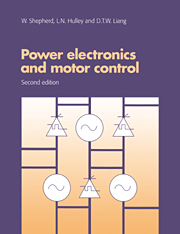Book contents
- Frontmatter
- Contents
- Preface to first edition
- Preface to second edition
- List of principal symbols
- 1 Power switching theory
- 2 Switching devices and control electrode requirements
- 3 System realisation
- 4 Adjustable speed drives
- 5 D.c. motor control using a d.c. chopper
- 6 Controlled bridge rectifiers with d.c. motor load
- 7 Three-phase naturally commutated bridge circuit as a rectifier or inverter
- 8 Single-phase voltage controllers
- 9 Three-phase induction motor with constant frequency supply
- 10 Induction motor slip-energy recovery
- 11 Induction motor speed control by the use of adjustable voltage, adjustable frequency step-wave inverters
- 12 Induction motor speed control by the use of adjustable frequency PWM inverters
- Appendix General expressions for Fourier series
- Answers to problems
- References and bibliography
- Index
6 - Controlled bridge rectifiers with d.c. motor load
Published online by Cambridge University Press: 05 June 2012
- Frontmatter
- Contents
- Preface to first edition
- Preface to second edition
- List of principal symbols
- 1 Power switching theory
- 2 Switching devices and control electrode requirements
- 3 System realisation
- 4 Adjustable speed drives
- 5 D.c. motor control using a d.c. chopper
- 6 Controlled bridge rectifiers with d.c. motor load
- 7 Three-phase naturally commutated bridge circuit as a rectifier or inverter
- 8 Single-phase voltage controllers
- 9 Three-phase induction motor with constant frequency supply
- 10 Induction motor slip-energy recovery
- 11 Induction motor speed control by the use of adjustable voltage, adjustable frequency step-wave inverters
- 12 Induction motor speed control by the use of adjustable frequency PWM inverters
- Appendix General expressions for Fourier series
- Answers to problems
- References and bibliography
- Index
Summary
THE PRINCIPLES OF RECTIFICATION
The process of electrical rectification is where current from an a.c. supply is converted to a unidirectional form before being supplied to a load. Although unidirectional, the load current may pulsate in amplitude, depending on the load impedance. With resistive loads the load voltage polarity is fixed. The polarity of the voltage across series-connected load inductance elements may vary during the load current cycle.
In a rectifier circuit there are certain electrical properties that are of interest irrespective of circuit topology and impedance nature. These properties can be divided into two groups, (i) on the supply side, and (ii) on the load side of the rectifier, respectively. When the electrical supply system has a low (ideally zero) impedance, the sinusoidal supply voltages remain largely undistorted even when the rectifier action causes nonsinusoidal pulses of current to be drawn from the supply. For the purposes of circuit analysis one can assume that semiconductor rectifier elements, such as diodes and thyristor devices, are ideal in that they are dissipationless and have zero conducting voltage drop.
A study of rectifier circuits is basically a study of waveforms. No energy is stored within a rectifier so that there is a constant connection between the currents and voltages on the a.c. side and the current and voltage on the d.c. side. In rectifier calculations the essential requirement is to obtain an accurate physical picture of the operation and then establish circuit equations that are valid for the particular condition.
- Type
- Chapter
- Information
- Power Electronics and Motor Control , pp. 190 - 235Publisher: Cambridge University PressPrint publication year: 1996

